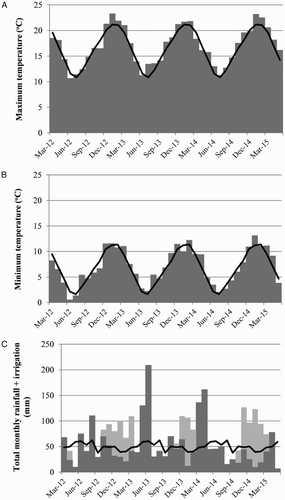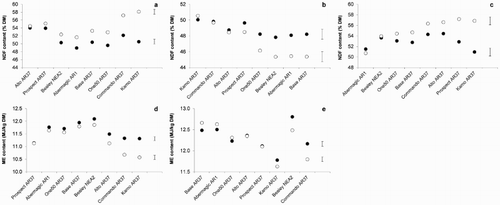Figures & data
Figure 1. Average monthly maximum temperatures (A) and minimum temperatures (B), and total rainfall (▪) plus irrigation water applied (▪) (c) from March 2012 to May 2015. The grey bars represent data during the experiment while the black lines represent the 30-year means.

Table 1. Seasonal and total annual adjusted herbage accumulation (kg DM/ha) from pastures sown with (plus) or without (minus) clover, and receiving High or Low rates of nitrogen (N) fertiliser annually.
Table 2. Seasonal and total annual adjusted herbage accumulation (kg DM/ha) from pastures sown with eight different perennial ryegrass cultivars with contrasting morphology and heading dates.
Figure 2. Significant nitrogen (N) × cultivar interaction detected in the seasonal adjusted herbage accumulation data during winter 2013. Pastures were sown with eight different perennial ryegrass cultivars and received High (▪) or Low (□) rates of N fertiliser annually. The error bars indicate the maximum standard error of the difference for comparing N treatment means for a cultivar as well as cultivars within each N treatment.

Table 3. Seasonal nutritive value characteristics from pastures sown with (plus) or without (minus) clover, and receiving High or Low rates of nitrogen (N) fertiliser annually.
Table 4. Seasonal nutritive value characteristics from pastures sown with eight different perennial ryegrass cultivars.
Figure 3. Significant clover × cultivar interactions detected in neutral detergent fibre (NDF) concentration data during (A) summer 2012/2013, (B) late spring 2013 and (C) summer 2014/2015, and in metabolisable energy (ME) density data during (D) summer 2012/2013 and (E) summer 2013/2014. Pastures were sown with eight different perennial ryegrass cultivars with (●) or without (○) clover. The error bars indicate the maximum standard error of the difference for comparing clover treatment means for a cultivar as well as cultivars within each clover treatment.

Figure 4. Seasonal botanical composition of pastures during late spring (LSp), summer (Sum) and autumn (Aut). The four treatments were: HN+c, High nitrogen (N) plus clover; HN-c, High N minus clover; LN+c, Low N plus clover; and LN-c, Low N minus clover. Components include perennial ryegrass (grey), white clover (white), unsown species (black) and dead material (diagonal lines).

